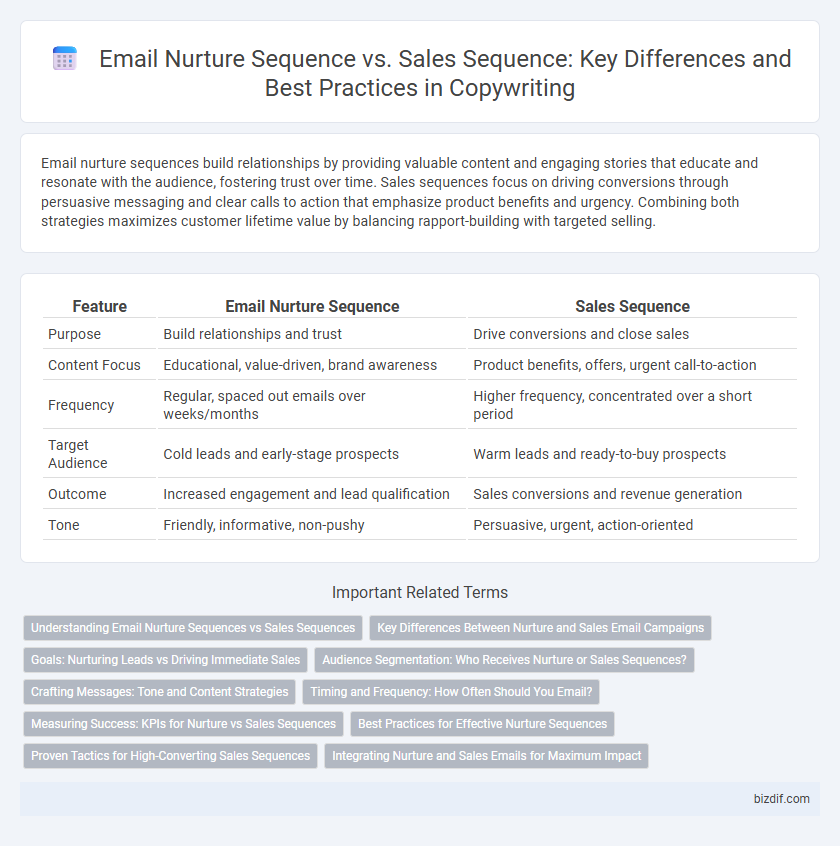Email nurture sequences build relationships by providing valuable content and engaging stories that educate and resonate with the audience, fostering trust over time. Sales sequences focus on driving conversions through persuasive messaging and clear calls to action that emphasize product benefits and urgency. Combining both strategies maximizes customer lifetime value by balancing rapport-building with targeted selling.
Table of Comparison
| Feature | Email Nurture Sequence | Sales Sequence |
|---|---|---|
| Purpose | Build relationships and trust | Drive conversions and close sales |
| Content Focus | Educational, value-driven, brand awareness | Product benefits, offers, urgent call-to-action |
| Frequency | Regular, spaced out emails over weeks/months | Higher frequency, concentrated over a short period |
| Target Audience | Cold leads and early-stage prospects | Warm leads and ready-to-buy prospects |
| Outcome | Increased engagement and lead qualification | Sales conversions and revenue generation |
| Tone | Friendly, informative, non-pushy | Persuasive, urgent, action-oriented |
Understanding Email Nurture Sequences vs Sales Sequences
Email nurture sequences focus on building relationships and trust by providing valuable content tailored to leads' interests over time, enhancing engagement without immediate sales pressure. Sales sequences prioritize driving conversions through targeted calls-to-action and urgency, aiming to move prospects quickly through the sales funnel. Understanding these distinctions enables marketers to strategically deploy emails that either cultivate long-term loyalty or accelerate purchase decisions effectively.
Key Differences Between Nurture and Sales Email Campaigns
Email nurture sequences focus on building relationships by providing valuable, educational content that addresses subscriber pain points and fosters trust over time. Sales sequences prioritize driving immediate action through persuasive messaging, clear calls to action, and limited-time offers aimed at converting leads into customers. The key difference lies in nurturing email campaigns emphasizing engagement and rapport, while sales campaigns concentrate on closing deals and generating revenue.
Goals: Nurturing Leads vs Driving Immediate Sales
Email nurture sequences focus on building trust and engagement by providing valuable content that educates and addresses leads' pain points over time. Sales sequences prioritize driving immediate conversions through targeted offers, clear calls-to-action, and urgency-driven messaging. Effective copywriting tailors the tone and content to align with these distinct goals, maximizing long-term relationship building or short-term revenue generation.
Audience Segmentation: Who Receives Nurture or Sales Sequences?
Email nurture sequences target segmented audiences who have shown initial interest or engaged with lead magnets, aiming to build trust through valuable content over time. Sales sequences focus on warm leads or prospects nearing the decision stage, delivering tailored offers and calls-to-action to drive conversions. Precise audience segmentation based on behavior, engagement level, and buyer persona data ensures each sequence maximizes relevance and response rates.
Crafting Messages: Tone and Content Strategies
Email nurture sequences prioritize building trust and relationship through personalized, value-driven content that addresses the recipient's pain points and interests, using a conversational and empathetic tone. Sales sequences focus on persuasive messaging with clear calls-to-action, highlighting benefits, urgency, and overcoming objections to drive conversions. Crafting messages in nurture sequences leans toward educational and supportive language, while sales sequences employ confident, action-oriented content to motivate immediate responses.
Timing and Frequency: How Often Should You Email?
Email nurture sequences focus on building relationships over time with a steady cadence, typically sending one to two emails per week to maintain engagement without overwhelming recipients. Sales sequences ramp up frequency as the offer dates approach, often sending emails every two to three days to create urgency and drive conversions. Optimizing timing and frequency in both sequences ensures that audiences receive relevant content aligned with their buyer's journey stages without causing fatigue.
Measuring Success: KPIs for Nurture vs Sales Sequences
Key performance indicators for email nurture sequences typically include metrics like open rates, click-through rates, and engagement duration, which reveal how effectively the content builds trust and educates prospects over time. In contrast, sales sequences prioritize conversion rates, lead-to-customer ratio, and revenue generated per email, as these KPIs directly measure the sequence's ability to close deals and drive sales. Monitoring these distinct KPIs ensures marketers can optimize both nurture and sales sequences according to their unique goals in the customer journey.
Best Practices for Effective Nurture Sequences
Effective email nurture sequences prioritize personalized content tailored to the recipient's interests and behaviors, fostering trust and engagement over time. Segmentation and timely follow-ups based on user actions maximize relevance, while subtle calls-to-action encourage progression without overwhelming the prospect. Consistent testing of subject lines, email copy, and send times ensures continuous optimization of open and conversion rates within nurture campaigns.
Proven Tactics for High-Converting Sales Sequences
Sales sequences leverage targeted email nurture tactics such as personalized storytelling, urgency triggers, and clear calls-to-action to boost conversion rates significantly. Incorporating behavior-based segmentation and timely follow-ups increases engagement and moves prospects efficiently through the sales funnel. Proven high-converting sales sequences consistently outperform generic nurture sequences by addressing specific pain points and offering tailored solutions backed by social proof.
Integrating Nurture and Sales Emails for Maximum Impact
Integrating email nurture sequences with sales sequences enhances customer engagement by seamlessly guiding prospects through awareness to conversion while building trust and providing value. Nurture emails focus on educating and establishing relationships, whereas sales sequences drive urgency and action; combining these strategies creates a cohesive journey that maximizes open rates and click-through rates. Data-driven segmentation and personalized content within this integrated approach increase ROI by aligning messaging with customer intent and behavior throughout the funnel.
Email Nurture Sequence vs Sales Sequence Infographic

 bizdif.com
bizdif.com